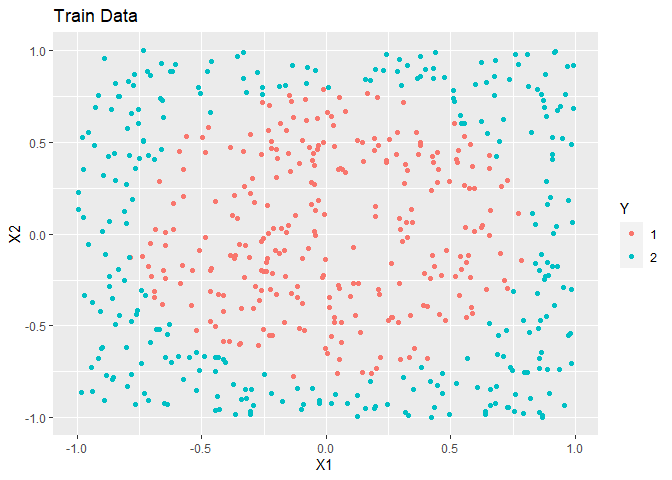
The hardware and bandwidth for this mirror is donated by METANET, the Webhosting and Full Service-Cloud Provider.
If you wish to report a bug, or if you are interested in having us mirror your free-software or open-source project, please feel free to contact us at mirror[@]metanet.ch.

In k nearest neighbors, the shape of the neighborhood is usually circular. Discriminant Adaptive Nearest Neighbors (dann) is a variation of k nearest neighbors where the shape of the neighborhood is data driven. The neighborhood is elongated along class boundaries and shrunk in the orthogonal direction. See Discriminate Adaptive Nearest Neighbor Classification by Hastie and Tibshirani.
This package brings the dann package into the tidymodels ecosystem.
Models:
In this example, simulated data is made. The overall trend is a circle inside a square.
knitr::opts_chunk$set(echo = TRUE, fig.width = 10, fig.height = 10)
library(parsnip)
library(rsample)
library(scales)
library(dials)
library(tune)
library(yardstick)
library(workflows)
library(tidydann)
library(dplyr, warn.conflicts = FALSE)
library(ggplot2)
library(mlbench)
# Create training data
set.seed(1)
circle_data <- mlbench.circle(700, 2) |>
tibble::as_tibble()
colnames(circle_data) <- c("X1", "X2", "Y")
set.seed(42)
split <- initial_split(circle_data, prop = .80)
train <- training(split)
test <- testing(split)
ggplot(train, aes(x = X1, y = X2, colour = as.factor(Y))) +
geom_point() +
labs(title = "Train Data", colour = "Y")
AUC is nearly perfect for these data.
model <- nearest_neighbor_adaptive(neighbors = 5, neighborhood = 50, matrix_diagonal = 1) |>
set_engine("dann") |>
fit(formula = Y ~ X1 + X2, data = train)
testPredictions <- model |>
predict(new_data = test, type = "prob")
testPredictions <- test |>
select(Y) |>
bind_cols(testPredictions)
testPredictions |>
roc_auc(truth = Y, event_level = "first", .pred_1)
#> # A tibble: 1 × 3
#> .metric .estimator .estimate
#> <chr> <chr> <dbl>
#> 1 roc_auc binary 0.991In general, dann will struggle as unrelated variables are intermingled with informative variables. To deal with this, sub_dann projects the data onto a unique subspace and then calls dann on the subspace. In the below example there are 2 related variables and 5 that are unrelated.
######################
# Circle data with unrelated variables
######################
# Create training data
set.seed(1)
circle_data <- mlbench.circle(700, 2) |>
tibble::as_tibble()
colnames(circle_data) <- c("X1", "X2", "Y")
# Add 5 unrelated variables
circle_data <- circle_data |>
mutate(
U1 = runif(700, -1, 1),
U2 = runif(700, -1, 1),
U3 = runif(700, -1, 1),
U4 = runif(700, -1, 1),
U5 = runif(700, -1, 1)
)
set.seed(42)
split <- initial_split(circle_data, prop = .80)
train <- training(split)
test <- testing(split)Without careful feature selection, dann’s performance suffers.
model <- nearest_neighbor_adaptive(neighbors = 5, neighborhood = 50, matrix_diagonal = 1) |>
set_engine("dann") |>
fit(formula = Y ~ ., data = train)
testPredictions <- model |>
predict(new_data = test, type = "prob")
testPredictions <- test |>
select(Y) |>
bind_cols(testPredictions)
testPredictions |>
roc_auc(truth = Y, event_level = "first", .pred_1)
#> # A tibble: 1 × 3
#> .metric .estimator .estimate
#> <chr> <chr> <dbl>
#> 1 roc_auc binary 0.759To deal with uninformative variables, a sub_dann model with tuned parameters is trained.
# define workflow
sub_dann_spec <-
nearest_neighbor_adaptive(
neighbors = tune(),
neighborhood = tune(),
matrix_diagonal = tune(),
weighted = tune(),
sphere = tune(),
num_comp = tune()
) |>
set_engine("sub_dann") |>
set_mode("classification")
sub_dann_wf <- workflow() |>
add_model(sub_dann_spec) |>
add_formula(Y ~ .)
# define grid
set.seed(2)
finalized_neighborhood <- neighborhood() |> get_n_frac(train, frac = .20)
finalized_num_comp <- num_comp() |> get_p(train[-1])
grid <- grid_random(
neighbors(),
finalized_neighborhood,
matrix_diagonal(),
weighted(),
sphere(),
finalized_num_comp,
size = 30,
filter = neighbors <= neighborhood
)
# tune
set.seed(123)
cv <- vfold_cv(data = train, v = 5)
sub_dann_tune_res <- sub_dann_wf |>
tune_grid(resamples = cv, grid = grid)
best_model <- sub_dann_tune_res |>
select_best(metric = "roc_auc")With the best hyperparameters found, a final model on all training data is fit. Test AUC improved.
# retrain on all data
final_model <-
sub_dann_wf |>
finalize_workflow(best_model) |>
last_fit(split)
final_model |>
collect_metrics() |>
filter(.metric == "roc_auc") |>
select(.metric, .estimator, .estimate)
#> # A tibble: 1 × 3
#> .metric .estimator .estimate
#> <chr> <chr> <dbl>
#> 1 roc_auc binary 0.985These binaries (installable software) and packages are in development.
They may not be fully stable and should be used with caution. We make no claims about them.